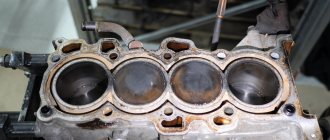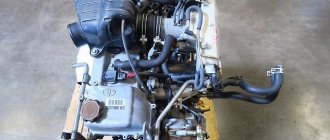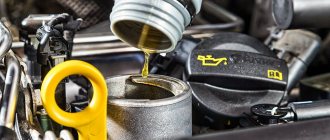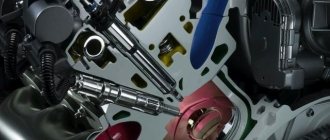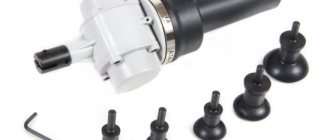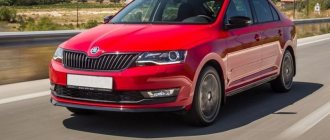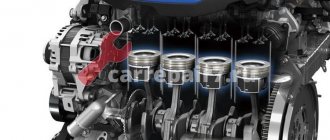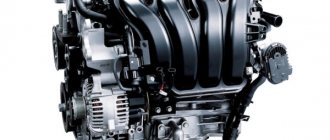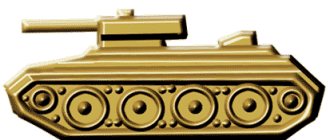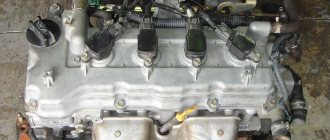Motors with 14, 16, 18, 20 or more cylinders.
How many cylinders does your car have? We are sure that most of you will answer - three or four. To our regret, most automakers began to reduce the number of cylinders in engines while maintaining the same power, and all thanks to new technologies and, of course, with the help of turbines. Therefore, in recent years, cars with eight or more cylinders in the engine have become rare. However, certain car companies continue to produce powerful cars with V8 or W12 power units. What do you think, are there vehicles with powerful engines larger than 12 cylinders, which, for example, have 14, 16, 18 or more cylinders in the engine?
In one insurance company, we came across a seemingly ordinary questionnaire, which is filled out when applying for a Casco policy, in which there was the following question:
“Indicate the number of cylinders in your car’s engine.” Answer options for this question were offered: from 1 to 24 cylinders. This surprised us very much and we decided to find out for ourselves which cars and vehicles have engines with cylinders larger than 12.
Strange engines: eight cylinders transversely, 12 in a row and many others
Modern automakers do not particularly spoil us with a variety of engines. In-line “fours”, “sixes”, V6 and V8 - this is the main set of our time. But very original configurations have been encountered in world history! We’ll talk about them today at Drome.
In our time of total unification, modular designs, common platforms, downsizing and strict environmental standards, automakers - especially in the mass segments - usually have no choice: only a four- or even three-cylinder engine. These are the realities, these are the layouts, this is, whatever one may say, the near future. “Americans”, SUVs and premium cars still use more “serious” configurations - V6, V8, L6 - but this, apparently, is not for long: the example of Volvo immediately comes to mind, all of whose engines - both gasoline and diesel - have four cylinders and 2.0 liters of volume. Not so long ago, BMW and Mercedes-Benz engineers announced that the V12 configuration would be retained in the name of status and image. And now these German companies no longer have such engines. Now 12-cylinders are the prerogative of sports cars and real “luxury” cars like Bentley.
But this was not always the case, and many still remember those glorious times when normal displacement and the “correct” configuration were held in high esteem. Nowadays you won’t even find such “prose” as transversely located in-line “fives” and “sixes”. You probably remember the Audi or Volvo models, as well as the Chevrolet Epica, but did you know about the Bugatti with a transverse (!) inline 8-cylinder engine? Today we will look a little further and deeper, remember which cars had the strangest engines for the first time, and even give some examples from the very recent past.
Straight-Eight (1919)
Configuration - inline 8-cylinder Manufacturers: Isotta Fraschini, Bugatti, Leyland Motors, Duesenberg
It's no secret that a number of car engine configurations come from the airline industry. The inline 8-cylinder engine - usually quite powerful and long - was ideal for airplanes with their cigar-shaped shape. The first car for which such an engine was adapted was the Isotta Fraschini Tipo 8A in 1919. A year later, this configuration was tried by Leyland Motors, but the design was most loved by Bugatti (in Europe) and Duesenberg in the States. In the middle photo is one of the most beautiful cars in history - a gigantic (6.2 m in length, 1.65 m - the “extent” of the hood) Bugatti 41 Royale Coupe with a 12.8 liter engine that produced 275 hp . and as much as 785 Nm of torque! The craftsmen from Bugatti also had the idea to “stick” an 8-cylinder “in-line” across the body of the Type 251 racing model, which, with a volume of only 2.5 liters, “spun” up to 9000 rpm and developed 250 hp. As far as we know, the solution is unique to this day. Much later, one little-known Italian company came up with the idea of placing a V16 engine transversely, but more on that later...
Straight-Twelve (1920)
Configuration - inline 12-cylinder Manufacturers: Corona, Packard
Packard Straight 12
It would seem that it was already much longer than the hood of the same Bugatti 41 Royale Coupe, but, apparently, not everyone at that time read Freud, so just a year later - in 1920 - the monstrous idea of building an in-line 12-cylinder unit. Such a power unit with a volume of 7238 cm³ was even assembled, but the cost of its production was prohibitive, and the length did not allow installation in any of the existing cars. A little later, the Packard company built a single copy of a long limousine with a Straight-Twelve engine configuration, which, according to legend, was driven by one of the members of the Packard family until he died in 1929, and the masterpiece was simply sold for scrap.
Where are 12-cylinder engines used?
For air and water transport, such engines are quite common. As for the modern automotive industry, they are often installed in production models by Ferrari and Lamborghini. On the Russian market you can find W12 engines in cars of the German automaker Volkswagen. Recently, 12-cylinder engines began to be produced in Barnaul, using the pre-war V12 diesel engine as a prototype.
Such power plants are installed on diesel locomotives, on drilling rigs, and as a drive for pumps and compressor units.
In addition to Ferrari, such engines are installed in cars from Rolls-Royce and Pagani; these are mostly classic V12s, most suitable for use in passenger cars.
History of the development of 12-cylinder engines
The first designer who managed to create a working prototype of a 12-cylinder engine is Daimler Gottlieb, and he took the project developed by Leon Levavassor as the basis for his engine. At the beginning of the 20th century, such power units were installed on marine boats and motor boats from the Société Antoinette company. Replacing four cylinders with 12 made it possible to significantly increase power and performance, so these engines were very popular.
In 1904, the Putney Motor Works company, using the developments of its predecessors, developed and launched the first V-twin engines, which became widespread in a variety of fields. In 1909, Renault released an engine aimed at the aviation industry, which for the first time featured rows of pistons at an angle of 60° and used air cooling.
The characteristics of the engine are not impressive by today's standards: with a volume of 12.3 liters, the cylinder diameter was 95 mm and the piston stroke was 140 mm. In 2010, the French released a more compact version of the motor, designed for motor boats and motorboats. Two years later, a 17.5-liter liquid-cooled power unit appeared, developing a power of 135 kW and spinning the crankshaft up to 1400 rpm.
In 2013, Sunbeam Motor Car managed to design an engine with similar characteristics, intended for installation in cars (piston L - 15.0 cm, cylinder D - 8.0 cm). The first model on which an engine with 12 pistons was tested was the Toodles V, which managed to break several speed records.
On the eve of World War II, it was engines with 12 pistons that became the main ones for heavy military equipment. After its end and a long period of recession and industrial recovery, these motors were undeservedly consigned to oblivion.
And only in 1972, the famous British automaker Jaguar released an innovative for that time 5.3-liter X12 engine, which revived the mass production of 12-cylinder power units. The model turned out to be so successful that it was produced until 1996. Today, such motors have become even more advanced, powerful and economical (relative to their predecessors).
Operating procedure
On a 12-cylinder engine, the "running order" implies a specific starting sequence. This process is responsible for how the same cycles of the device alternate, in which they are connected by a single crankshaft. The order of operation is influenced by several different reasons. These include factors such as:
- camshaft structure;
- arrangement of cylinders inside the power plant;
- a type of crankshaft.
The operation of a 12-cylinder engine largely depends on the valve timing, which makes up this process. Their sequence should be distributed in proportion to the force of influence on the crankshaft. According to the scheme, cylinders that operate in series should not be located in adjacent places. Regardless of the type of engine that differs in the type of cylinder arrangement, work begins with the main device number 1.
For example, the duty cycle starts from the first cylinder. After the crankshaft makes a rotation of 90 degrees, the operation of mechanism 5 begins, then the cycle starts sequentially in other blocks. If the engine is tuned correctly, it will run smoother and smoother than a six- or eight-cylinder.
Service Features
Owners of vehicles with a 12-cylinder engine are familiar with the nuances of servicing these devices. They are distinguished by their unpretentiousness and long service life.
If the adjustment was done correctly, then the intervention of a professional auto mechanic will not be needed until 15-20 thousand km have been covered. After a major overhaul, when the engine is reinstalled, you need to properly adjust the mechanism, if necessary, using the help of professionals.
Types
There are several varieties of 12-cylinder engines. They differ only in layout options. These include the following subspecies:
- V12 – has a v-shaped structure with devices that are placed opposite each other. During installation, an angle of 60 degrees is maintained.
- L12 - has an in-line arrangement of cylinder blocks. The common crankshaft is rotated by pistons. This variety is a combined configuration of a two-stroke and four-stroke engine. This 12-cylinder diesel engine is distinguished by its small width and sufficient length. They are not used in mechanical engineering, but only on ships.
- X12 is a power plant with a special cylinder arrangement. They are installed in 3 rows of four pieces. Here the piston also rotates the crankshaft that connects them.
- F12 – it is also called “opposite” due to its unusual configuration. The angle between the blocks is 180 degrees. It is characterized by its compact size and low center of gravity. Such a power unit is rarely found in production cars. But it can often be seen on sports vehicles.
This number of varieties helps designers experiment with the performance and driving characteristics of vehicles, equipping them with one or another engine.
With an addition!
More than a century ago, soon after the advent of eight-cylinder automobile engines, it became clear that this would not be the end of the matter. The race for power, especially for large prestigious cars, was in full swing. And with the technologies of the first decades of the last century and the quality of gasoline at that time, power could only be increased by increasing the working volume. But “inflating” the cylinders means impairing the smooth operation of the engine. Increasing its length is also not a good idea, although attempts have been made to build in-line 12-cylinder units. So, the logical path is the V12 engine.
Aviation helped a lot with this. Engines for cars and airplanes at the beginning of the century were very similar, and, as a rule, they were designed by the same engineers. The first, not yet production, but record-breaking cars were powered by aircraft engines. In particular, the British Sunbeam of 1913 is one of the contenders for the championship in the “car with a V12 engine” category. Its nine-liter engine developed, according to rough estimates, a colossal 200 horsepower for those years. The cylinder camber was 60 degrees, which is still considered the most successful scheme from the point of view of balance. Aluminum cylinder block - with steel liners.
The next step was taken in 1915 by the American company Packard, releasing the Twin Six production model. In no other country in the world, besides the USA, were there then enough buyers for such a car. The 60-degree V12 engine had overhead valves (imagine the acrobatics required to adjust them) and had permanent cylinder heads. For the first time in the USA, aluminum pistons were used. The 7-liter unit developed 90 hp, which was ridiculous by our standards, but very respectable for those times.
Strictly speaking, the first such engine was prepared for a production car back in 1927 by the American company Marmon, but it was able to put it into production six months later than Cadillac. The eight-liter unit of the Marmon Sixteen car was noticeably more powerful than the Cadillac one: it developed 200 hp. against 165 forces. But the Marmons did it for only three years and during this time they assembled only 350 cars - ten times less than the V16 Cadillacs of all modifications.
Varieties of 12-cylinder power units
There are many types of such motors, including quite exotic and rare ones:
- L12 - an internal combustion engine with an in-line arrangement of all twelve cylinders, in which the forces of all pistons are directed to rotate the crankshaft. It is characterized by simplicity of design, excellent balance, small width and significant length, which makes it impossible to use this type of engine in passenger cars. But they are very common in shipbuilding;
- V12 – engines with a V-shaped cylinder arrangement (two rows of 6, located opposite each other at an angle of 60°). The most common variety in the automotive industry;
- W12 is a W-shaped twelve-cylinder engine, characterized by more compact dimensions compared to its V12-cylinder counterpart. The main disadvantage of such units is that they are less balanced and do not achieve such smooth operation as those of their opponents;
- The X12 is a twelve-cylinder engine in which one crankshaft rotates three rows of cylinders (four in each row). Due to the complexity of implementation, this option is rare;
- The F12 is an opposed internal combustion engine, which differs from the V12 in the opposed arrangement of the rows of cylinders with a three times larger angle (180°) between them. This design allows for increased width and lower height, as well as a low center of gravity. Such varieties are used mainly in sports and racing cars; they are installed extremely rarely on production cars.

